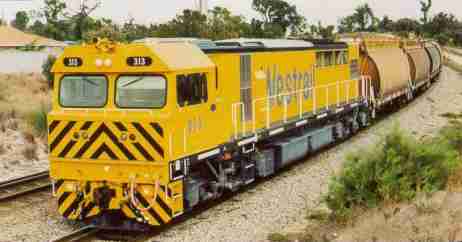
Westrail S class diesel-electric locomotives
courtesy Westrail website prior to its dismantling

Westrail P, Q, S and DB class diesel-electric locomotive simulators

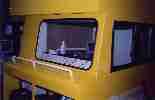
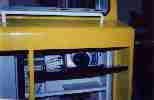

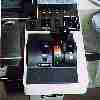


The actual cab exterior of a locomotive is shown on the left, followed by the final testing phase of the cab and associated equipment in pictorial form, with some of the design team conferring while resolving an anomaly. We see a front three-quarter view of the cab and a close-up of the video projector under the windscreen.
The view from the cab door behind the driver (left hand position), looking past an out-of-focus seat headrest, shows brake levers mounted on the inside of the left side wall just below the sliding window, with the horn joystick (out of sight) in front of it. Ahead is the bare desktop, devoid of "back-hoe controls", with the two touch-screen monitors below the windscreen, and the throttle controls on an island protruding rearwards from the desktop towards the driver on his right hand side.
This is almost a mirror image of that in the right hand drive position in the equivalent QR locomotive (4000 class).
The computer monitor to the right of the desktop is about the only thing that gives the installation away as not being a real locomotive. That, and the car-radio style speaker enclosures in the mansard ceiling section to left and right which we have not photographed; these provide engine, track, and pneumatic (air and horn) sounds for realistic ambience for the driver under instruction.
The throttle island is shown in more detail in the next shot, followed by two images of design team in consultation
Although not a driver by profession, having driven the simulator for half an hour, and then standing in the cab observing others driving it for a further hour, I can confirm that it really is remarkably close to the real thing.
The unit was repainted in its new owners' colours and delivered by road to them in Perth - Australian Rail Group (who had recently bought Westrail towards the end of the simulator's construction phase) - where acceptance trials are currently being undertaken.
The other photos above show various aspects of the installation...
next we see finishes touches being put to the airconditioning system prior to final testing... the instructor's workstation, with two seventeen-inch and two fourteen inch slim monitors (very nice!)...
penultimately a very difficult picture to succesfully capture due to lighting conditions, but here one sees the simulator being driven on one of the narrow gauge tracks in the south-west of Western Australia being projected on to a screen some six feet or so in front of the driver's window...
The final shot is the unit ready for the road. Speculation is now rife that having trialled an S-class in South Australia and Victoria, new Westrail owners Australian Rail Group will bring the simulator back here from time to time for driver training and familiarisation on other main line routes, as well as reorganising their assets to provide modern motive power to finally be able to compete on a level playing-field with the (still) government owned National Rail Corporation.
Editor's footnote... there is still bad feeling among many railwaymen towards the Keating Federal Labour Government who stripped the assets from Australian National, giving all of its fuel-efficient newer locomotives to its new 'baby' National Rail in the early 90s, in a deal reminiscent of "Bottom of the Harbour" activities which the same government succesfully prosecuted businesses for being involved in.
Australian Rail Group is a subsidiary of Gennessee Wyoming Australia, in turn owned by the highly succesful New York state based short-line operator Genessee Wyoming Inc who purchased the defunct Australian National in November 1997, and who successfully tendered to construct the Alice Springs to Darwin extension of the Central Australia Railway - an extension promised by the Federal Government since the second decade of last century.
Almost all of the American GWI locomotive fleet is of General Motors origin. As was much of Westrail, Australian National and VicRail.
Genessee Wyoming Australia has as consortium partners Clyde Industries (now EDI) for maintenance; it should be remembered that Clyde Engineering manufactured almost every single General Motors locomotive used in Australia. The exception was six WAGR A-class erected at Bassendean WA by Comonwealth Engineering because of the latter's South African subsidiary Union Carriage and Wagon also having an EMD licence for manufacture at that time.
Australia Western Railroad, the new corporate name for what was Westrail, is a wholly owned subsidiary of Gennesse Wyoming Australia, whose headquarters has now moved to Perth, leaving Australia Southern Railroad to manage its own affairs here in Adelaide.
Copyright footnote... In 1999 verbal approval was given this webmaster by the then public Relations Manager of Westrail to reproduce on this internet web-site various past and current photographs attributed to Westrail, and its predecessor, the Western Australian Government Railways. The photograph of S313 at the head of this page is therefore reproduced here in good faith of that agreement, and is included solely to illustrate what the real locomotive looks like in action.
If you are interested in other simulators, you may like to visit my simulator page on this site. It will open in a new window.
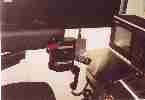
Above the driver's head is the vigilance button - correctly placed as in the prototype - and quite difficult to reach unless the driver is tall, and it would appear to be likely to cause fatigue. This is flanked by a pair of speakers (also to the right hand side as well, producing appropriate sound effects. A tiny camera is also there, showing the instructor the driver's behaviour while under instruction...
Sydac Section Navigation
back to start
- 3000 QR
- 4000 QR
- Westrail
- other sims